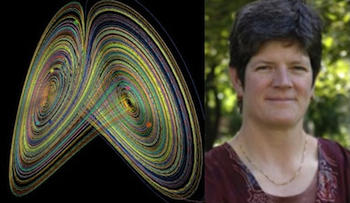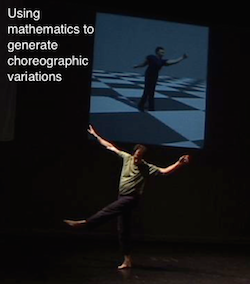
- 23 Aug 2015
Liz Bradley, the course instructor for Nonlinear Dynamics, takes a few minutes to describe her course, the changes she has made in this second offering of the course, and a little bit about her current research. Liz Bradley is Professor at the University of Colorado, Department of Computer Science and Electrical and Computer Engineering. She is also External Professor and Science Board member at the Santa Fe Insititute.
Why is it important to understand nonlinear dynamics if someone is interested in complex systems?
It’s important to understand nonlinear dynamics because the world is dynamical and nonlinear, though most of what we learn in high school and college is about linear systems. The world is dynamical in the sense that it moves, grows and evolves, and few of the relationships between important things in the world are really linear.
Complex systems and nonlinear dynamics are two sides of the same coin. We can think about chaos as complex behavior coming from simple systems, whereas I think one of the really fundamentally interesting things about complex systems science is simple behavior coming from complex systems. Say you have 100,000 fish, and with the interaction of these individual fish (in a perhaps nonlinear way) something simple emerges: a single school of fish.
This is your second time offering this course through complexity explorer. Did you decide to change anything based on your experience last year?
Yes, I’m going to include more applications — something students requested last year. It’s basically an ideas/mathematics course, but people really enjoyed the applications I did. For example, I took a video camera down to the creek by my office, and explored one of the metaphors that we use in the course — an eddy in a creek — and dropped some woodchips into it. People seemed to get a lot out of that, so I plan to do some more of those and connect them back to the ideas & mathematics.
I also plan to do a bit more interviewing of people on the University of Colorado campus about their research, and try to tie things together: the science, the mathematics, the applications, and the people that are carrying out the work in this fascinating field.

Which of the course’s units is your favorite, and why?
My favorite unit is the last one. It’s the last unit because it draws on concepts and ideas from every one of the previous nine units, and it has a whole bunch of applications in it. For example, I talk about chaos in the solar system and applications of chaos to choreography. The students in the course last time wanted more of that, but there’s a bit of a chicken and the egg problem because you can’t do that kind of stuff without first laying the groundwork for people to understand it.
Sadly, it’s not possible to take that unit and spread it across the entire course, but it’s perhaps possible to talk more about other applications, or a bit of foreshadowing of the ones I do in the last unit, earlier in the course.
Is there anything you’re particularly excited about that you’re working on at the moment that you’d like to share with us?
I have two hats that I wear. One is nonlinear dynamics and the other is artificial intelligence. They’re pretty much disjoint; I don’t have very much research that straddles the two. My group has people in it who are doing hardcore statistical AI, and others that are doing nonlinear time-series analysis. My nonlinear dynamics work right now focuses on classic time-series analysis and prediction, very much in the spirit of stuff that was started at SFI in the 90s by Andreas Weigend and Neil Gershenfeld in the time series prediction competition, and dating further back to Doyne Farmer and Jim Crutchfield and all the Prediction Company people. We’re working on new ways to combine nonlinear dynamics and information theory, and to do a better job of predicting nonlinear dynamical systems. For many of the techniques in the field, you need a tremendous amount of data, lots of elbow grease, and lots of mathematics, and that’s not realistic if you’re trying to predict something that’s moving fast.
On the AI side right now, I have a big project working with a group of paleo-scientists on how to automate the process of analysis of an ice or sediment core. Analyzing these cores results in terabytes of data. The first task in the analysis is to deduce the age-depth relationship, which requires PhD level training and a year to do a core, so this is a very good task for AI to weigh in, and we’re building an AI tool that does that. It captures the reasoning of expert scientists to do this complex, subtle, and highly repetitive analysis.
Tell us a little about “Chaos and Coffee”.
One of the frustrating things about teaching a MOOC is not having much personal contact with the students. To increase this personal contact, I set up these meetings that I called “Chaos and coffee”. Whenever I was travelling, I would post to the forum and say, “I’m going to be in Berlin next month, who wants to do chaos and coffee?” And not very many people took me up on that, and I wish they would do it more.
Enroll in Nonlinear Dynamics here. Watch Liz Bradley introduce her course in this video.
